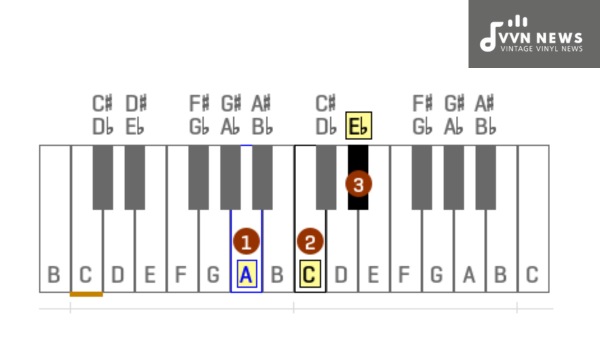The rudiments of music theory can seem like a daunting task at first glance, however, there’s no need to fret, as it all boils down to getting the basics right.
One such basic concept we’ll be delving into today is the diminished triad. In the complete guide on a diminished triad, I aim to deconstruct this key element of music theory and present it in an easy and highly engaging format, perfect for both beginners and seasoned enthusiasts alike.
Navigating through the varied landscape of music theory becomes less complicated when you start recognizing patterns and familiar structures.
A perfect starting point is learning about chords and their many versions; one that is often misunderstood or overlooked is the diminished triad; but that’s about to change because this complete guide is here to help you know what it is, why it’s so important, and how to use it.
Take a deep breath, tune up your instruments, and let’s strike the right chord on this musical journey together.
What is a diminished triad?
A diminished triad is a three-note chord consisting of two minor thirds stacked on top of each other.
It is unique because it creates a dissonant and unstable sound, which can add tension and suspense to your musical compositions.
The diminished triad is less commonly used compared to major and minor triads but has its distinct flavor.
Here are the main points about diminished triads:
- Structure: A diminished triad consists of the root note, flattened (lowered) third, and flattened fifth. For example, in the key of A, the A diminished triad would include the notes A, C, and Eb.
- Characteristics: The diminished triad has a distinct dissonant quality due to its symmetrical structure of minor thirds.
- Difference from Major and Minor Triads: Unlike major or minor chords that have a stable and resolved sound, the diminished triad creates tension and begs for resolution.
- Symbol Notation: Diminished chords are often notated with either “dim” or “°” after the chord name (e.g., Adim or A°).
- Inversions: Like major and minor chords, diminished triads can be played in different inversions to change their voicing or create unique progressions.
- Use in Music Composition: Diminished triads are commonly used as passing chords or transitional elements in music composition due to their unstable nature.
- Application: These chords can be found in various genres such as jazz, classical music, and even heavy metal.
The concept of a diminished triad opens up new avenues for harmonic exploration in your music compositions.
By incorporating these unusual chord structures into your arrangements, you can create intriguing melodic tension that commands attention from your listeners.
Stay tuned for further sections in this guide where we’ll explore different aspects of the diminished triad in more detail.
Also Read: G Diminished Triad [Guide To Unique Guitar Chords]
What are the differences between major, minor, and diminished triads?
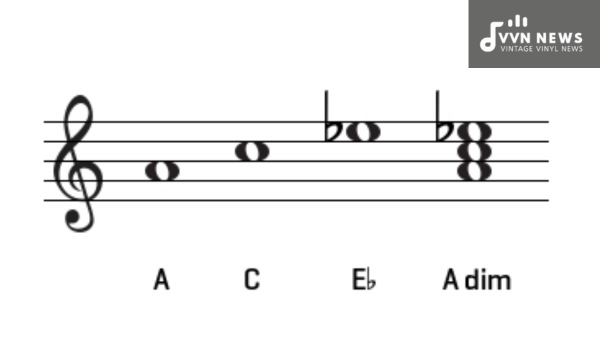
The differences between major, minor, and diminished triads is essential in music theory.
These three types of triads form the foundation of chord progressions and have distinct characteristics that evoke different emotions in a musical composition. Let’s break down each type and explore their unique qualities:
Major Triad:
- Structure: A major triad consists of a root note, a major third (four half-steps above the root), and a perfect fifth (seven half-steps above the root).
- Sound: Major triads have a bright and happy sound, creating a sense of stability and resolution.
- Symbol Notation: Major chords are usually notated with uppercase letters (e.g., C), without any additional symbols.
Minor Triad:
- Structure: A minor triad includes a root note, a minor third (three half-steps above the root), and a perfect fifth.
- Sound: Minor chords have a melancholic or sad quality that can convey introspection or sorrow in music. They often create tension that seeks resolution.
- Symbol Notation: Minor chords are typically notated with lowercase letters (e.g., Dm) or symbols like “-“.
Diminished Triad:
- Structure: A diminished triad is formed by combining two minor thirds. It consists of a root note, a lowered (flattened) third (three half-steps below the root), and a lowered fifth (six half-steps below the root).
- Sound: Diminished chords produce dissonance and tension due to their unstable nature. They create an ominous or suspenseful atmosphere that can be used for dramatic effect.
- Symbol Notation: Diminished chords are often notated with “dim” or “°” after the chord name (e.g., Edim or E°).
With these differences between major, minor, and diminished triads, you will develop a deeper knowledge of chord progressions and how to use them effectively in your music compositions.
Experimenting with these different types of triads will provide you with a wider range of emotions and moods to convey in your musical creations.
Also Read: B Diminished Triad [Master This Unique Guitar Chord]
What is the structure of A diminished triad?
The structure of an A diminished triad can be easily understood by breaking it down into its components.
- Root Note: The root note of the chord is A. This serves as the foundation upon which the entire triad is built.
- Flattened Third: The second note in the chord is the flattened (lowered) third, which gives the diminished triad its distinct sound. In the key of A, the third note would normally be C#, but in a diminished triad, it is lowered by one-half step to C.
- Flattened Fifth: The final note in the chord is the flattened (lowered) fifth. In the case of an A diminished triad, the fifth note would typically be E, but in this specific chord structure, it is lowered to Eb.
These three notes together form the structure of an A-diminished triad. It’s important to remember that all three notes are played simultaneously to create a cohesive and dissonant sound characteristic of this chord type.
What are the uses of an A diminished triad in music composition?
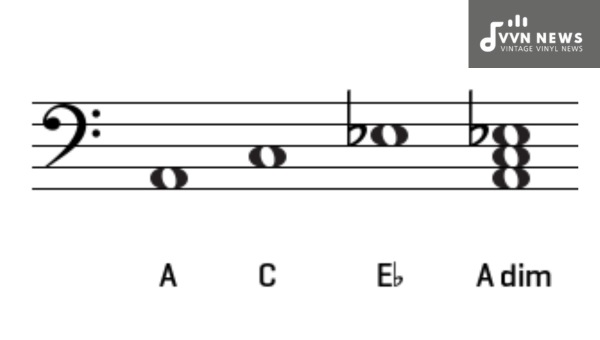
The A diminished triad, like any other diminished triad, has its own unique application in music composition. Here are a few ways that the A diminished triad can be used effectively:
- Building Tension: The dissonant and unstable nature of the A diminished triad makes it ideal for generating tension within a composition. It creates a sense of anticipation and can lead the listener to expect resolution.
- Passing Chord: The A diminished triad is often used as a passing chord, meaning it serves as a temporary bridge between two other chords. Its chromatic quality allows for smooth transitions between different tonalities or chords with shared notes.
- Modulation Tool: Diminished chords, including the A diminished triad, can be utilized for modulation purposes. By incorporating this chord at strategic points within a piece, you can smoothly transition to a new key or tonal area.
- Harmonic Filling: In certain genres like jazz and classical music, where complex harmonies are common, the A diminished triad can be used to add depth to chord progressions or fill in gaps between other chords.
- Harmonic Embellishment: Similar to passing chords, the A diminished triad can be used as an embellishing chord to add color and variation to a progression. This can create richer harmonies and make your compositions more interesting.
- Unique Melodic Patterns: The symmetrical structure of the diminished triad allows for unique melodic patterns that can enrich your compositions. By exploring different inversions and melodic sequences involving the A diminished triad, you can come up with distinctive musical motifs.
- Jazz Improvisation: Diminished chords are particularly common in jazz improvisation due to their flexibility and ability to create tension and movement. Musicians often use the A diminished triad as a launching point for melodic variations and improvisations.
The A diminished triad is just one tool in your musical arsenal. Its usage should always align with the overall context, style, and emotion you want to portray in your compositions.
Also Read: A Sharp Diminished Triad [Discover This Unique Chord]
Types of A diminished triad inversions
Inversions are alternate voicings of a chord that rearrange the order of the notes. They offer different melodic and harmonic possibilities, allowing for a more diverse and dynamic musical composition.
Let’s explore the various inversions of an A diminished triad and how they can be utilized:
Root Position
The root position is the standard form of the A diminished triad, with the root note A as the lowest pitch in the chord. In this position, the notes are arranged in intervals of minor thirds as A-C-Eb.
First Inversion
To create the first inversion, take the third note (C) from the root position and play it as the bass note.
The first inversion of an A diminished triad is C-Eb-A. This creates a unique harmonic texture and can be used to add variation to your compositions.
Second Inversion
The second inversion involves taking the fifth note (Eb) from the root position and playing it as the bass note.
The second inversion of an A diminished triad is Eb-A-C. This inversion produces a different tonal quality compared to other inversions, adding depth to your musical arrangements.
It’s worth noting that these inversions can be further expanded upon by doubling certain notes or using them in different octaves.
By incorporating these various inversions into your chord progressions, you can create an interesting melodic movement that captivates listeners’ attention.
It’s essential to experiment and explore which inversions work best for achieving your desired musical expression.
Also Read: G Major Triad [Revolutionize Your Music Knowledge Today]
What role does the A Diminished Triad play in chord progression?
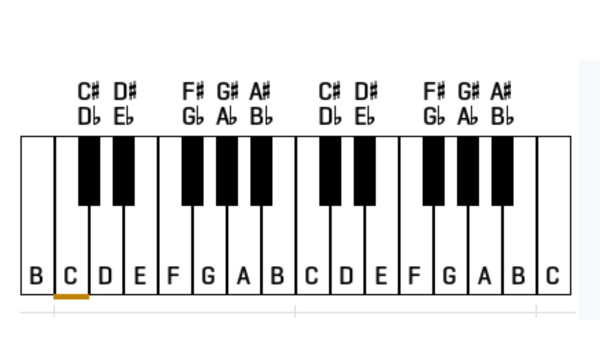
When it comes to chord progressions, the A Diminished Triad plays a unique and important role in adding intrigue and tension to musical compositions.
Let’s explore the various ways this chord can be used and its significance within a larger harmonic context.
- Passing Chord: The A Diminished Triad often functions as a passing chord, creating a smooth transition between two other chords. For example, in the key of C major, the progression F – Adim – G creates an interesting movement as the diminished triad acts as a stepping stone from F to G.
- Secondary Leading Tone Chord: In some cases, the diminished triad can be used as a secondary leading tone chord. This means that it leads into another chord that is not its tonic or root. For instance, in the key of D major, an F#dim can lead into a G major chord.
- Diminished Seventh Chord: Combining three minor thirds creates a diminished seventh chord. The A Diminished Triad can function as part of this more complex and dissonant chord structure. It consists of A – C – Eb – Gb (or enharmonically A – C – Eb – F#). This diminished seventh chord has versatile applications and can serve as a substitute for dominant chords or as chromatic passing chords.
- Chromatic Mediant: The relationship between A Diminished triad and other triads with roots separated by three whole steps is known as chromatic mediant modulation. This technique creates interesting harmonic movement by transitioning between chords that are harmonically distant but share common tones.
- Modal Interchange: The use of diminished triads from parallel or related modes adds color and variety to your composition. For example, borrowing an Adim from C major’s parallel mode (C minor) can add a unique flavor to your chord progression.
- Dominant Function: In certain contexts, the diminished triad can function as a substitute for a dominant chord. This substitution brings additional tension and drama to your music and creates unexpected harmonic resolutions.
Incorporating the A Diminished Triad into your chord progressions, you can elevate your musical compositions to new heights.
Its unique sound adds depth and complexity that captivates listeners and makes your music stand out.
Experiment with different progressions and explore the possibilities this chord has to offer in various musical genres.
Also Read: A Flat Major Triad [Simplify Complex Music Theory Today]
What is the notation for an A Diminished Triad on sheet music?
When it comes to reading and interpreting sheet music, the notation for chords is crucial.
The notation for an A diminished triad on sheet music is denoted using specific symbols and musical symbols.
Let’s break it down step by step to ensure a clear understanding of how to recognize and play an A diminished triad on sheet music.
- Chord symbol: The chord symbol for an A diminished triad is written as “Adim” or “A°.” This is typically placed above the staff, indicating that the upcoming notes should be played as an A diminished triad.
- Musical symbols: In standard music notation, a diminished triad is represented by two horizontal lines placed above the notes. These lines act as a shorthand way of denoting that the chord should be played in its diminished form.
- Note placement: On the staff, each note of the A diminished triad will have its specific position. The root note (A) will be written on a line or space, usually on or near the bottom line of the staff.
- Lowered third: As we know, a diminished triad has a lowered third interval compared to a major or minor triad. In the case of an A diminished triad, this means that the C note will be slightly lower than its natural position.
- Flattened fifth: Additionally, a diminished triad has a lowered or flattened fifth interval compared to major and minor chords. In the case of an A diminished triad, this means that the E note will also be slightly lower than its natural position.
Recognizing these notations on sheet music, you’ll be able to identify and play an A diminished triad with ease in your musical compositions.
It’s important to practice reading and interpreting sheet music regularly to enhance your overall proficiency as a musician.
How can one form the A diminished triad on Different Instruments?
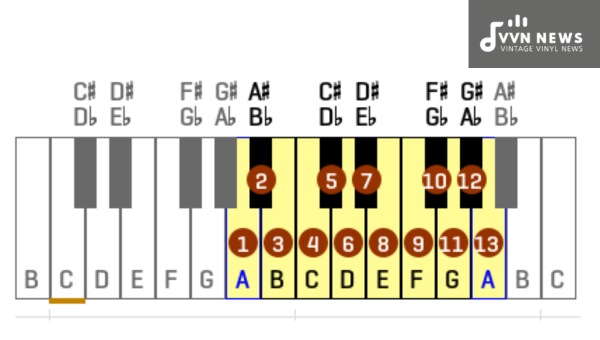
Forming a diminished triad on different instruments follows the same fundamental principles in music theory.
The specific fingerings and techniques may vary depending on the instrument you are playing. Let’s explore how you can form an A diminished triad on some common instruments:
Piano/Keyboard:
- Start by finding the A key on your keyboard. It is the white key located to the left of the set of three black keys.
- Place your middle finger on A, your index finger on C (which is two semitones above A), and your pinky finger on Eb (which is four semitones above A).
- Play all three keys simultaneously to create the A diminished triad.
Guitar:
- Begin by finding the note A on your guitar fretboard.
- For an open position, place your second finger (middle finger) on the 2nd fret of the 4th string (D string), your first finger (index finger) barring across all strings at the 1st fret, and place your ring finger onto the 3rd string at the 2nd fret.
- Strum or pluck across all strings from string 4 to string 1 to play an A diminished triad.
Bass:
- Locate and press down on the 5th fret of the E string with your index finger.
- Place your middle finger on the 6th fret of the D string.
- Press down on the 5th fret of G string with your pinky finger.
- Pluck or strum all three strings together to produce an A diminished triad sound.
No matter which instrument you play, it’s important to practice forming these chord shapes until they become natural and effortless for you.
As you become more comfortable with these shapes, try incorporating them into different musical contexts to explore the unique sound and possibilities of the diminished triad.
Remember to experiment and have fun with these chord shapes, as they can add depth and character to your playing.
Also Read: A Major Triad [Master This Building Block Of Music]
Songs that incorporate Diminished Chords
Diminished chords can add a unique and captivating flavor to songs across various genres. Here are some popular songs that make use of diminished chords in their compositions.
- “Falling in Love with Love” from the musical “The Boys from Syracuse”: This classic jazz standard by Richard Rodgers features several diminished chords, showcasing their ability to create tension and interest in a melodic passage.
- “Lucy in the Sky with Diamonds” by The Beatles: In this iconic psychedelic rock song, a descending chord progression during the bridge incorporates diminished chords, adding an otherworldly element to the music.
- “Stairway to Heaven” by Led Zeppelin: Led Zeppelin’s epic ballad employs a variety of chord progressions throughout its duration. In one section, they incorporate diminished chords to heighten the emotional atmosphere and build tension.
- “My Funny Valentine” from the musical “Babes in Arms”: This timeless jazz ballad written by Richard Rodgers and Lorenz Hart features a prominent diminished chord on the line “Your looks are laughable.” This use of a diminished chord adds complexity to the melody and lends itself well to emotional expression.
- “All Blues” by Miles Davis: As an influential jazz composition, this song has become a standard for jazz musicians. It incorporates diminished chords within its modal structure, creating harmonic interest and contributing to its laid-back and bluesy vibe.
- “Boulevard of Broken Dreams” by Green Day: This rock anthem features a guitar intro that includes a descending sequence of diminished chords, adding a somber tone that fits well with the melancholic lyrics.
- “Black Hole Sun” by Soundgarden: In this grunge-rock hit from the 1990s, Soundgarden incorporates diminished chords into their guitar riff, intensifying the overall mood of the song.
Incorporating diminished chords into your compositions can help you create unique sounds and evoke specific emotions in your music.
FAQ about the A Diminished Triad
Can a diminished triad be major or minor?
No, unlike major and minor chords, a diminished triad is its unique chord structure with a distinct dissonant sound.
How do I form an A diminished triad?
To form an A diminished triad, take the root note (A), lower the third by a half step (C), and lower the fifth by a half step (Eb).
What are the inversions of an A diminished triad?
The inversions of an A diminished triad are C-Eb-A, Eb-A-C, and A-C-Eb. Inversions rearrange the order of the notes while maintaining the same chord tones.
How can I incorporate an A diminished triad into my music composition?
Diminished triads can be used as passing chords or transitional elements in your compositions to add tension and move smoothly between other chords.
Are there any well-known songs that use diminished triads?
Yes! Songs like “Eleanor Rigby” by The Beatles and “All of Me” by Frank Sinatra use diminished chords to add depth and complexity to their melodic progressions.
Conclusion
The diminished triad is a unique and intriguing chord structure that adds tension and complexity to any musical composition.
With the construction of a diminished triad and its characteristics, you can leverage its dissonant sound to create captivating melodies.
Incorporating diminished triads into your music can elevate your compositions and showcase your creativity.
So, go ahead and experiment with these chords, explore different inversions, and see how they can enrich your musical journey.
